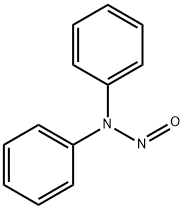Health effects
N-nitrosodiphenylamine is classified by the Environmental Protection Agency (EPA) as a probable human carcinogen. This is based on increased bladder tumors in male and female rats, an increase in reticulum cell sarcomas (a form of malignant lymphoma) in mice, and the chemical’s structural similarity to nitrosamines (known carcinogens). Animal studies involving chronic exposure to high levels of N-nitrosodiphenylamine resulted in cancer of the bladder and changes in body weight. The EPA considers N-nitrosodiphenylamine a hazardous waste, and spills exceeding 100 pounds must immediately be reported. Being exposed to N-nitrosodiphenylamine over a long period can cause cancer in animals, including bladder cancer and lymphoma, and may cause cancer in humans.
Chemical Properties
N-Nitrosodiphenylamine is a yellow to orangebrown crystalline solid. Soluble in acetone, benzene, ethyl acetate, dichloromethane, carbon tetrachloride, ether and carbon disulfide, soluble in hot alcohol, slightly soluble in gasoline, insoluble in water. In the hydrochloric acid methanol solution, a shift reaction can occur, and it can be transformed into p-nitrosodiphenylamine.
Uses
N-Nitrosodiphenylamine is the N-nitroso analogue of diphenylamine that was once used as a rubber additive but is no longer due to undesirable carcinogenic effects (1). N-Nitrosodiphenylamine may have potential carcinogenic activity and is currently classified as a probable carcinogen by EPA with genetic toxicity (2,3). Drinking water contaminant candidate list 3 (CCL 3) compound as per United States Environmental Protection Agency (EPA), environmental, and food contaminants.
Definition
ChEBI: N-Nitrosodiphenylamine is a member of phenylhydrazines. It is an industrial compound that formerly used as a vulcanization retarder in the rubber industry.
General Description
N-nitrosodiphenylamine appears as yellow to brown or orange powder or flakes or a black solid. Insoluble in water and denser in water. Hence sinks in water. (NTP, 1992)
Air & Water Reactions
Insoluble in water.
Reactivity Profile
N-Nitrosodiphenylamine may be sensitive to moisture at elevated temperatures in strongly acidic solutions. May react vigorously with oxidizing agents. May undergo trans-nitrosation reactions with secondary amines .
Health Hazard
ACUTE/CHRONIC HAZARDS: When heated to decomposition N-Nitrosodiphenylamine emits toxic fumes of nitrogen oxides.
Fire Hazard
Flash point data for N-Nitrosodiphenylamine are not available; however, N-Nitrosodiphenylamine is probably combustible.
Flammability and Explosibility
Non flammable
Safety Profile
Moderately toxic by
ingestion. An eye irritant. Questionable
carcinogen with experimental carcinogenic
and tumorigenic data. Human mutation data
reported. Dangerous fire hazard when
exposed to heat, flame, or oxidzing
materials. Can react vigorously with
oxidizing materials. When heated to
decomposition it emits highly toxic fumes of
NOx,. See also NITROSAMINES.
Potential Exposure
N-Nitrosodiphenylamine is not a naturally
occurring substance; it is a man-made chemical that is
no longer produced in the United States. It was used in the
manufacture of plastics, resins, rubber and synthetic textiles;
to help control processes involved in making rubber
products, such as tires and mechanical goods; however, in
the early 1980s, the United States manufacturers stopped
producing N-nitrosodiphenylamine because new and more
efficient chemicals were found to replace its uses. In addition,
the use of N-nitrosodiphenylamine had several undesirable
side effects which do not occur with the
replacement chemicals.
Carcinogenicity
Two feeding experiments with NDPhA in rats were totally
negative (no tumors). One used daily doses of 120 mg/kg
body weight to a total dose of 65 g/kg, and another used
a lower dose for only 53 weeks. Another experiment
involved larger groups of rats and mice and higher doses. In
mice, after 2 years, there was occasional hyperplasia of the
bladder mucosa, but no tumors; in rats given 4000 mg
NDPhA/kg diet for 2 years, 16/45 males and 40/49 females
had transitional cell carcinomas of the bladder. IARC classified
NDPhA as not classifiable as to carcinogenicity in
humans (Group 3).
Environmental Fate
Chemical/Physical. At temperatures greater than 85 °C, technical grades may decompose to
nitrogen oxides (IARC, 1978). N-Nitrosodiphenylamine will not hydrolyze because it does not
contain a hydrolyzable functional group (Kollig, 1993).
At influent concentrations of 10, 1.0, 0.1, and 0.01 mg/L, the GAC adsorption capacities were 510,
120, 91, and 38 mg/g, respectively (Dobbs and Cohen, 1980).
Shipping
UN2811 Toxic solids, organic, n.o.s., Hazard
Class: 6.1; Labels: 6.1-Poisonous materials, Technical
Name Required.
Incompatibilities
Incompatible with oxidizers (chlorates,
nitrates, peroxides, permanganates, perchlorates, chlorine,
bromine, fluorine, etc.); contact may cause fires or explosions.
Keep away from alkaline materials, strong bases,
strong acids, oxoacids, epoxides. Contact with reducing
agents may form hydrazine; hydrogen bromide. Light sensitive;
rapidly decomposes.
Waste Disposal
Burn in admixture with flammable
solvent in furnace equipped with afterburner and
scrubber.
References
[1] Peng, Xiuying et al. “Electrochemical sensor for facile detection of trace N-nitrosodiphenylamine based on poly(diallyldimethylammonium chloride)-stabilized graphene/platinum nanoparticles.” New Journal of Chemistry 2 (2018): 820–826.






